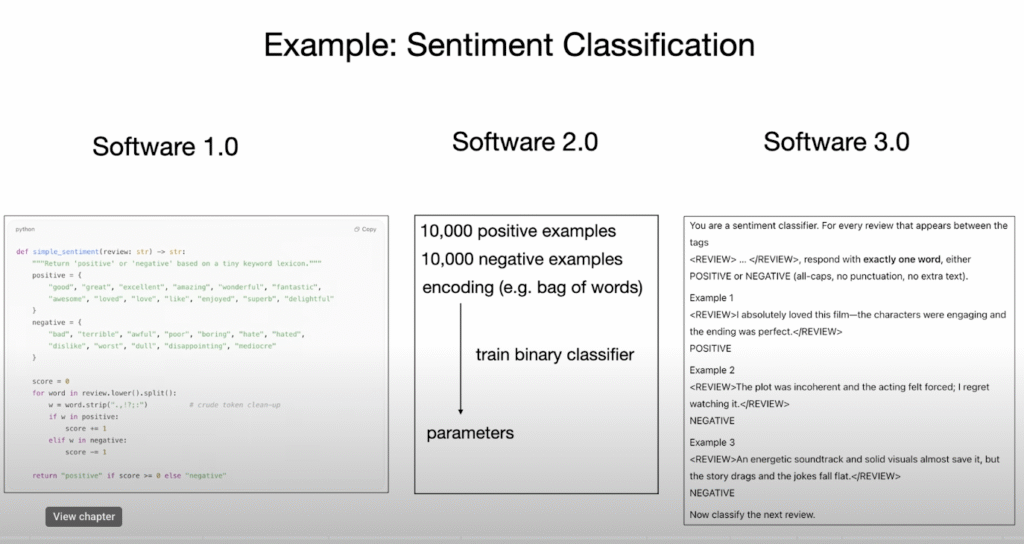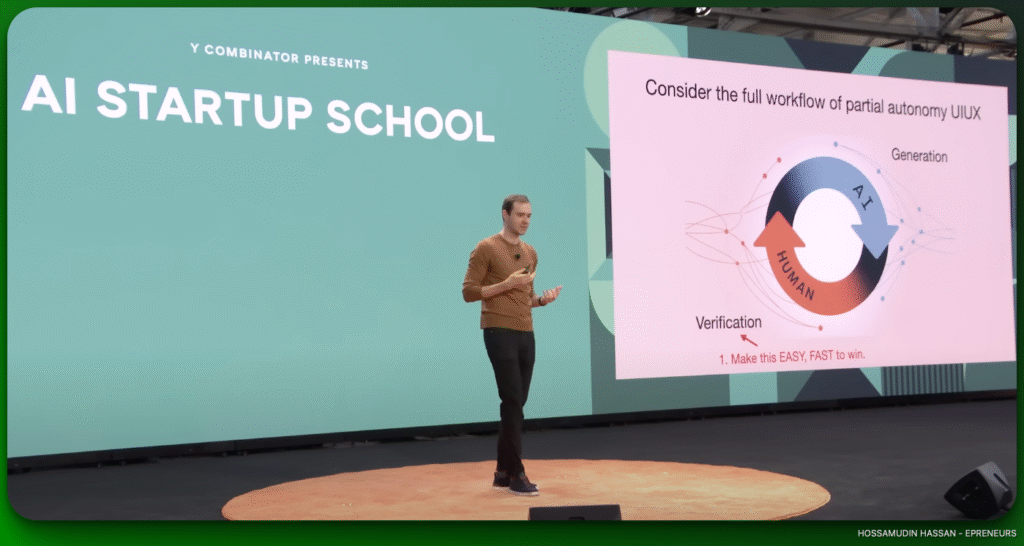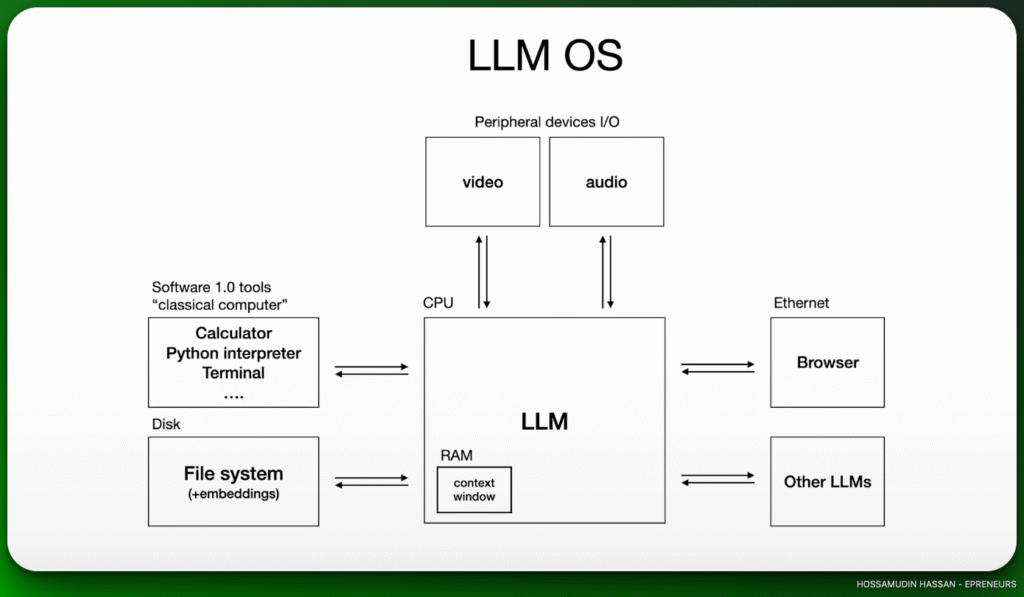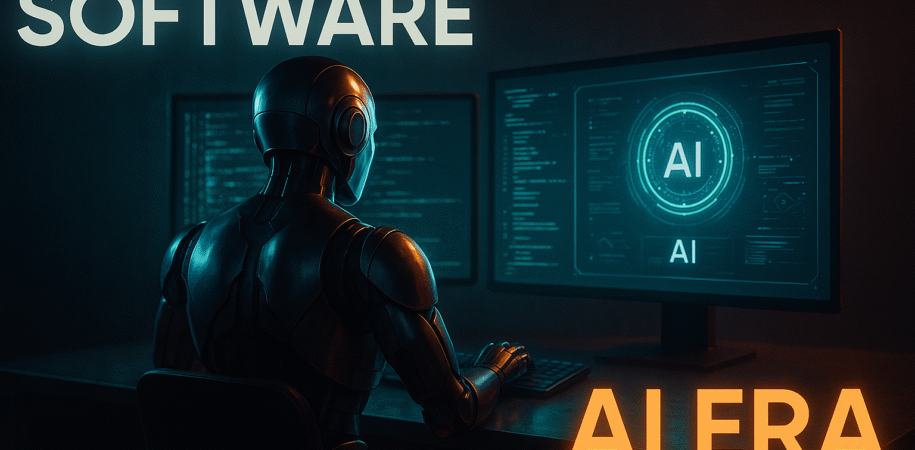Software has changed already! Today, anyone could open Bolt new or Windsurf or Lovable and start “vibe coding,” which is basically make AI (chatGPT) write code for them or even build full apps!
So, what does this mean for you as coder / software engineer especially if you’re a student?
This Talk by Andrej Karpathy, ex-tesla is answering most of those questions in your mind! “Here’s the summary, done in “augmentation” between Hossamudin hassan and AI “Gemini 2.5 Pro!”
Here’s the video: Andrej Karpathy: Software Is Changing (Again)
First let’s start with Key Concepts and Keywords:
- Vibe Coding: A new way of coding where you give in to the vibes and let the LLM do the work.
- Software 1.0: This is traditional software written by humans in programming languages.
- Software 2.0: This is software that uses neural networks and is created by optimizing weights based on data.
- Software 3.0: This is software created by prompting large language models (LLMs) in natural language.
LLM Psychology: The idea that LLMs have emergent psychological traits, including both strengths and weaknesses.
Partial Autonomy: The idea that software can be designed to have different levels of autonomy, from fully manual to fully autonomous.
First, LEt’s discover: Software 1.0, Software 2.0 and Software 3.0.


Key Timeline Points:
- 1940s: Software 1.0 becomes programmable.
- 2012: AlexNet revolutionizes image recognition, marking the rise of Software 2.0.
- 2019: Large language models (LLMs) become programmable, ushering in the era of Software 3.0.
- 2013: The speaker’s first demo drive in a Waymo car.
- 2015-2025: The decade of “driving agents.”
Key Advice:
- If you’re entering the industry, be fluent in all three programming paradigms (1.0, 2.0, and 3.0).
- When building LLM apps, focus on the user interface and user experience (UI/UX) to make the verification loop as fast as possible.
- Keep the AI on a leash and don’t get too overexcited about AI agents.
- When working with AI, it’s more about building Iron Man suits than Iron Man robots.
A Guide to Software in the Era of AI
Andrej Karpathy’s presentation at the AI Startup School provides a compelling vision for the future of software in the era of AI. He argues that we are in the midst of a third major paradigm shift in software development, following the transitions from manual to programmable software (Software 1.0) and from traditional code to neural networks (Software 2.0). This new paradigm, which he calls Software 3.0, is characterized by the ability to create software by prompting large language models (LLMs) in natural language. Karpathy explores the psychological traits of LLMs, the importance of partial autonomy in software design, and the opportunities for building a new generation of software that is more accessible and powerful than ever before.

The world of software is undergoing a profound transformation, and the key to understanding this shift lies in recognizing the three major paradigms of software development: Software 1.0, 2.0, and 3.0.
Software 1.0: The Age of Manual Coding
Software 1.0, which began in the 1940s, is the traditional way of building software. It involves writing explicit instructions in a programming language that tells a computer what to do. This paradigm has been the dominant force in software development for over 70 years, but it is now being challenged by the rise of AI.
Software 2.0: The Rise of Neural Networks
Software 2.0 emerged around 2012 with the advent of deep learning and the success of models like AlexNet. In this paradigm, software is not written by humans but is instead created by optimizing the weights of a neural network based on a large dataset. This approach has led to breakthroughs in areas like image recognition and natural language processing, but it is still limited by the need for large amounts of labeled data.
Software 3.0: The Era of Large Language Models
The latest paradigm, Software 3.0, is all about programming with natural language. With the rise of large language models (LLMs) like GPT-3, we can now create software by simply describing what we want it to do in English. This has made software development more accessible than ever before, and it is opening up new possibilities for what we can build.
The Psychology of LLMs
As we enter the era of Software 3.0, it’s important to understand the psychological traits of LLMs. They are not just simple tools but are more like “people spirits” with their own strengths and weaknesses.
Strengths
- Encyclopedic Knowledge: LLMs have been trained on a vast amount of text and code, giving them an encyclopedic knowledge of the world.
- Superhuman Memory: They can remember vast amounts of information and can recall it with perfect accuracy.
Weaknesses
- Hallucinations: LLMs can sometimes make up facts or generate nonsensical responses.
- Jagged Intelligence: They can be superhuman at some tasks but struggle with others that are easy for humans.
- Anterograde Amnesia: LLMs have no long-term memory and can’t learn from their mistakes.
- Gullibility: They are susceptible to prompt injection attacks and can be easily tricked into revealing private information.
Partial Autonomy: The Key to Building Better Software
The key to building successful software in the era of AI is to embrace the concept of partial autonomy. Instead of trying to build fully autonomous agents, we should focus on creating “Iron Man suits” that augment human capabilities. This means designing software with an “autonomy slider” that allows users to choose the level of assistance they want, from fully manual to fully autonomous.
The LLM Operating System.

The Future of Software
The future of software is not about replacing humans with AI but about creating a new generation of tools that are more accessible, powerful, and collaborative. By understanding the three paradigms of software development, the psychology of LLMs, and the importance of partial autonomy, we can build a future where everyone has the power to create and innovate.
Want to learn more about AI? follow Hossamudin Hassan now on Youtube.
Hossamudin’s Arabic channel (@ePreneurs) – Hossamudin’s English channel










